Genesis G80 splits off to lift Hyundai’s image
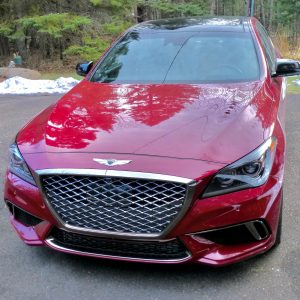
The Genesis model is now Hyundai’s separate luxury-sporty sedan line, amd the 2018 G80 AWD is a winner for all seasons.
By John Gilbert
When South Korea burst upon the elite level of auto design and technology, it was the 2011 Sonata that led the charge, with over-the-top contours, high-strength steel construction, and an advanced direct-injected 2.4-liter 4-cylinder engine with a lighter and more efficient in-house 6-speed transmission.
After that breakthrough in the midsize class, Hyundai went on to upgrade every engine and design to high-tech advancements. It also quickly added a larger and more luxurious Genesis sedan, which began life with a V8 engine that carried all of Hyundai’s self-taught technology. It won Car of the Year awards and the engine won Ward’s engine design awards.
My intention here is to renew acquaintances with the mainstream Genesis G80, a true combination of sportiness and luxury in a solid, strong-performing sedan. But before we get to the details of this beautifully redesigned G80, it still is important to scan Hyundai’s rapid expansion in the industry.
Hyundai added still another upscale super-luxury car called the Equus, above the Genesis, to present a full arsenal of vehicles, from tiny Accent, to compact Elantra, sporty — if oddball — Veloster coupe, the all-new Ioniq hybrid-or-electric compact, then to the Sonata, Azera, Genesis and Equus. On the side, its SUV group had the compact Tucson, and the larger Santa Fe, among others. All this time, Hyuundai had just taken on Kia as an affiliate, then partner, building parallel models and sharing in Hyundai’s breakthrough technology. The attempt now is to differentiate between Hyundai and Kia models, making Kia’s the sportier and Hyundai’s the more mainstream or luxurious.
As the 2017 model year blends into the 2018s, Hyundai is attempting to spin Genesis off into its own line, not unlike Acura for Honda, Infiniti for Nissan and Lexus for Toytoa, although far less prominent than those Japanese competitors. Hyundai eliminated the Equus moniker, condensing the car into the top-level Genesis model as the G90. The Genesis G70 is on the more compact, sporty side. In fact, the G70 is the Hyundai version of the much-promoted new Kia Stinger, which has been voted one of three finalists for North American Car of the Year.
Finally, I hear you say, we’re getting to today’s topic, which is the Genesis G80 — the Genesis model numerically between the sportiest G70 and the most luxurious G90.
Price range for the Genesis models is high-$30,000 for the G70, somewhere in the $50,000 range for the G80, and into the $70,000 level for the G90. Far beyond the mid-$20,000 to mid-$30,000 range of the Sonata.
With all of that stored away, the G80 is a superb sedan, living up to the rave reviews a colleague of mine has issued after buying a G80 a couple of years ago. It is, however, significantly redone for 2018, and the test model was, officially, the G80 AWD 3.3T Sport.
My test vehicle was not just a sporty or luxury sedan, but a stunning combination of every asset a car-buyer might want, need, or dream about. It handles with sporty flatness in turns, and is rock-solid over all manner of roadway, and you can dial it back from the sporty end of the adaptive Sport suspension to soften the ride.
Painted a seductive Sevilla Red, with special sporty wheels, the G80 came equipped with Hyundai’s proprietary HTrac all-wheel drive system and a smooth-shifting 8-speed upgrade of its transmission. Paddle shifters on the steering wheel add to the sporty flair.
Mostly, though, the sportiness comes from the 3.3-liter twin-turbocharged V6. Yes, the V8 is still available, now up to 5.0 liters in displacement, and it has 420 horsepower and 383 foot-pounds of torque. And a larger 3.8-liter V6 is available, with a fully adequate 311/293 horsepower/torque ledger. But the 3.3 is now massaged with twin turbocharging to 365 horsepower and 376 foot-pounds of torque — a perfect compromise.
Smooth power for freeway driving, surges ahead when you coax the throttle, and playing with manual shifting is always satisfying. With all the latest technical features, such as lane departure detection and assist in staying on your side of the line, blind-spot alert, park assist items with full surround rear cross-traffic warning and the nav-screen coming alive with a top-down view of every side of your G80.
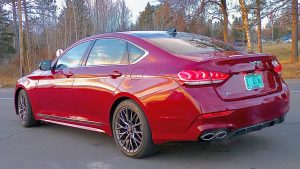
High-tech lighting front and rear, a stunning red option, and sporty wheels that house huge Brembo brakes are Genesis features.
You also get a 17-speaker Lexicon audio system that, I guarantee, will allow you to hear subtle background musical sounds you never realized were on some of your old favorite CDs, when pushed through the Quantum Logic surround system.
The test car came loaded, at $58,725, and while the EPA estimates highway mileage of 24, we found that getting about 21 was more realistic in combined city-highway driving.
It must be pointed out that you could stay in the Hyundai family and buy two of the newly redesigned 2018 Sonatas for that sticker price. Put another way, you could buy a Sonata for half the money and double your fuel economy.
But you would miss out on the superb all-wheel-drive system, the abundance of power, the luxurious appointments of the leather-dominated interior, the massive audio system, and the cute little flashing of the winged Genesis logo on the ground whenever you enter at night.
The G80 is placed in a hotly competitive and lucrative market segment, to compete with the BMW 5-Series, Audi A6, Mercedes E-Class, Lexus GS, Infiniti Q70, and Cadillac CTS. In that crowd, some are sporty, others are luxurious, but as a late-comer, in its AWD Sport trim, it offers the best of South Korean technology with a sporty flair.


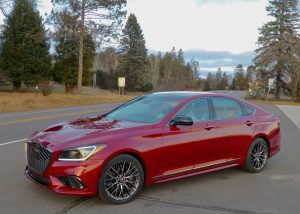
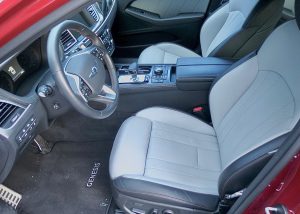
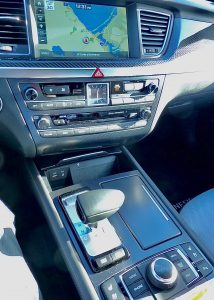
 John Gilbert is a lifetime Minnesotan and career journalist, specializing in cars and sports during and since spending 30 years at the Minneapolis Tribune, now the Star Tribune. More recently, he has continued translating the high-tech world of autos and sharing his passionate insights as a freelance writer/photographer/broadcaster. A member of the prestigious North American Car and Truck of the Year jury since 1993. John can be heard Monday-Friday from 9-11am on 610 KDAL(www.kdal610.com) on the "John Gilbert Show," and writes a column in the Duluth Reader.
John Gilbert is a lifetime Minnesotan and career journalist, specializing in cars and sports during and since spending 30 years at the Minneapolis Tribune, now the Star Tribune. More recently, he has continued translating the high-tech world of autos and sharing his passionate insights as a freelance writer/photographer/broadcaster. A member of the prestigious North American Car and Truck of the Year jury since 1993. John can be heard Monday-Friday from 9-11am on 610 KDAL(www.kdal610.com) on the "John Gilbert Show," and writes a column in the Duluth Reader.